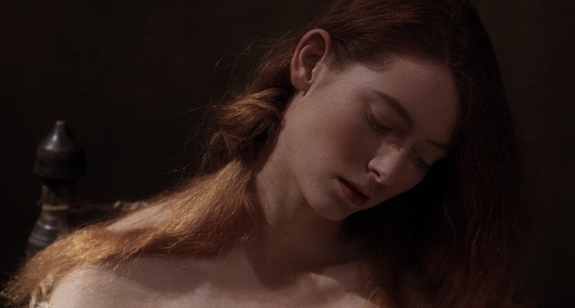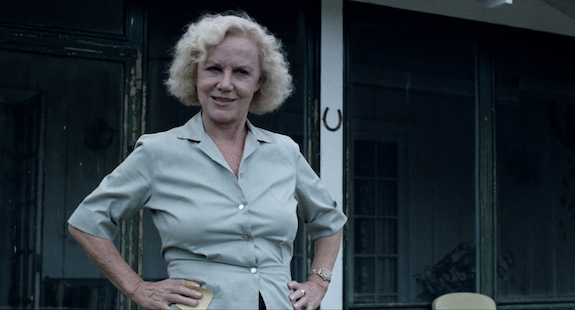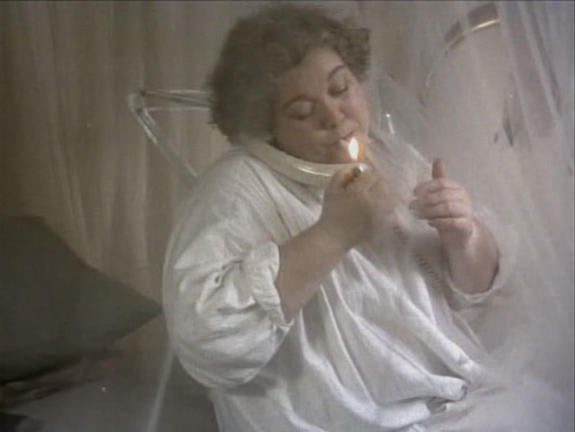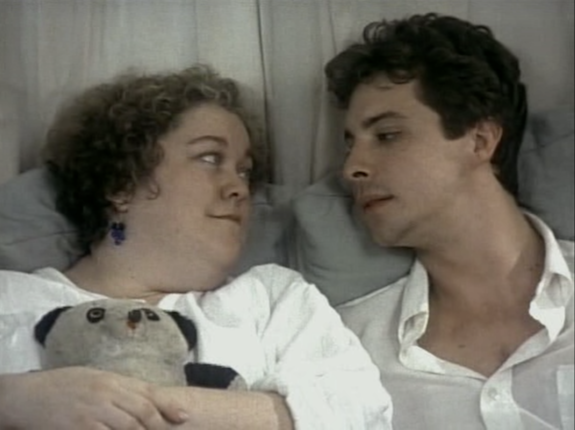1986: Straight Best Friends
 Sunday, August 15, 2021 at 6:08PM
Sunday, August 15, 2021 at 6:08PM Before each Smackdown, suggestions for alternates to Oscar's roster...
 Tilda Swinton in "Caravaggio"
Tilda Swinton in "Caravaggio"
1986 was, from the digging I've done, a fascinating year for queer cinema. Some of the films originated in '85 but belatedly hit the US in 1986, disparate efforts such as Desert Hearts, My Beautiful Laundrette, A Nightmare on Elm Street 2, and What Have I Done To Deserve This?!. Meanwhile, Working Girls premiered at that year’s Cannes but didn’t get a US release until February 1987. All of these films showed up in one form or another alongside pure-cut ‘86 releases like Parting Glances and Caravaggio, indicating a shifting tide of indie and mainstream cinema with vested, complex, even sympathetic interests in LGBT themes and characters, often made by queer filmmakers. Not only that, but the films themselves are risky and provocative. Save for the deeply unpleasant Mala Noche, all are worth real engagement, and you couldn’t go wrong checking out any of them.
Still, it must be asked - what about the straight people? What is their contribution here? What about the S.B.F.? Y’know, the Straight Best Friend?
Edith Massey has the answers, and some of these characters couldn't really be called “friends”. But even within this lifestyle of sick boredom, 1986's queer films boast a number of noteworthy characterizations, gay or straight, with reliably intriguing work from their supporting actresses. With props to Rita Wolf’s frisky, restless suitor in My Beautiful Laundrette, and to the cadre of appealingly played sex workers and Ellen McEludf’s uptight madame in Working Girls, here are three of the best straight best friends a queer could ask for.
Tilda Swinton, Caravaggio
Caravaggio, a loose biopic about the pioneering Baroque painter, was the cinematic debut of Tilda Swinton, and began a series of six collaborations with Derek Jarman that would continue until his death in 1994. Swinton arrives roughly half an hour into the film as Lena, the beggar girlfriend of the street fighter Ranuccio (Sean Bean, smoldering), who finds himself as the newest muse and lover of the titular painter (Nigel Terry, yowza). Lena is wary of Caravaggio’s attention towards her man, but they’re familiar enough with the practices and rewards of letting a wealthy type spoil them to pull out of this arrangement. Even more crucially, they seem to genuinely love each other, and don’t consider Caravaggio’s physical and economic pleasures a threat to their relationship.

This, of course, comes before Lena herself becomes a muse and lover of Caravaggio, which she is far more excited about than Rannuccio is. She’s swept off her feet by the quality of the fabrics she wears to pose for him, and by the ardor in his eyes when he studies the color and composition of her face and body. It’s one of the purest examples of a love triangle I’ve ever seen, where all three characters are visibly aroused and excited by each other but also weary that they’ll end up as the third wheel. Eventually, Lena becomes a figure of intrigue in Italian high society, and ascends to an even higher echelon of status and comfort than Caravaggio or Ranuccio can give her before exiting their lives completely.
Hers is the boldest arc in Caravaggio, one that’s already dramatized quite capably through makeup and costuming even without an actor’s contribution. Jarman already knows how to use Swinton’s peculiar beauty as a character point, gradually transforming her from dirt-caked androgyny to feminine grandeur. But Swinton is just as intrigued by the confluence of aestheticized histories and hot-blooded human behavior as Jarman is, and she embodies Lena’s ascension from street urchin to high-society mistress through physical comportment and a total sincerity in mood and appetite.

Compare Swinton's impact to Terry and Bean, and it’s clear how much she herself is doing to enrich Jarmen’s concepts. Swinton makes it clear that Lena really loves Ranuccio, and she’s just as passionate in dramatizing her attraction to Caravaggio and seduction by the finer things in life without making Lena seem less sincere in hindsight. She’s simply a different woman by her last scene, an organic evolution from the Lena she was at the start without resembling her in any way. It’s almost ridiculous how much raw talent Swinton radiates the second she’s on camera, and it’s a miracle that every bit of potential that Caravaggio indicates has been gloriously realized for three decades.
Audra Lindley, Desert Hearts
As expected, it’s the lesbian film that has the most female characters scattered around. Donna Deitch’s film is set in 1959, when a woman could acquire a quick divorce in Reno, Nevada via establishing residency after living there for six weeks. Desert Hearts follows 35-year-old literature professor Vivian Bell (Helen Shaver, excellent), who begins a relationship with younger free spirit Cay Rivvers (Patricia Charbonneau) while waiting for her divorcec to be finalized. Anyone in the market for mature, handsome tales of ultiimately triiumphant lesbian relationships should see this ASAP.

There’s a handful of women orbiting Shaver and Charbonneau, some of whom leave more of an impact than others. Nashville’s Gwen Welles has a breezy, appealing energy as one of Charbonneau’s lovers, and Katie La Bourdette pushes a bit hard as an acquaintance bravely willing to overstep personal boundaries to uphold social standards or dig up hot goss. I would’ve liked to spend more time with Silver (Andra Akers), whose gorgeous, gal-pal chumminess with Cay doesn’t seem to interfere with her upcoming marriage to a man. Spending more time with him and Silver would’ve been nice for further clarification on their arrangement, let alone as another example of the transient, atypical living arrangements that populate Desert Hearts.
Best of all is Audra Lindley’ performance as Frances Parker, a woman in her late 60’s who runs a guest house ranch that specifically caters to women who travel to Reno for a quick divorce. Lindley is instantly credible as a native of the Nevada plains, and her instant rapport with Shaver sets a tone of female camaraderie that Desert Hearts will quickly complicate. Frances reveals that the love of her life, Cay’s father, a man who she was with for ten years and had a son with before he suddenly died, was married when they first met. Eventually his wife left town over their affair, and Frances helped raise Cay for most of her childhood. Lindley plays this discussion with Vivian like Frances knows in her bones that she did something wrong, but it’s too intermingled with the joy and happiness that came from their affair. Her guilt isn’t compartmentalized from her rosiest memories but buried close enough under the surface that to dig too long brings melancholy she still hasn’t reckoned with.

Frances cares deeply for Cay, but she’s terrified of losing her, and quick to snipe at her flaws. Both of these concerns dovetail neatly around Cay’s lesbianism, which we sense truly bothers Frances but also offers her an opportunity to upbraid someone for a sin unlike the one she committed. This also means she’s quick to sour against Bell once she sees how quickly this educated outsider sparks to Cay. Without underlining hypocrisy or bluster, Lindley ably communicates that Frances is yelling at a younger version of herself as much as she’s yelling at Cay or Vivian, and that these anxieties are as wrapped up as every other joyous and unhappy thing that’s happened in her life. She’s a striking presence, upping the temperature inside Robert Elswit’s coolly textured images without disrupting them. Her last scene is a bit curtailed, but the arc from affability to suspicion to ambivalent reconciliation is memorably executed.
Kathy Kinney, Parting Glances
A quick side bar: What a tragedy that Bill Sherwood didn't live long enough to make another touching, humanist film after Parting Glances. Back to the show: We hear about Kathy Kinney’s Joan before we see her. She’s hosting a goodbye party for Robert (John Bolger) before he goes off for some two-year stint in Africa for his work. Neither Robert or his partner Michael (Richard Ganoung) are excited for the party, but mostly because they’re busy trying to find out if Robert leaving will annihilate a relationship that has been thriving until now. She gets a great, short entrance over a phone call, persuading the boys to come to her party while traipsing through her white bedroom like she’s in a perfume ad, lighting a joint and telling them to get their butts to her place. They show up around a third of the way into Parting Glances, and will spend the next half hour milling around with old friends and complete strangers while trying to sort out their own baggage.

More than anyone else in this article, Joan earns the moniker of the straight best friend. Granted, that’s not a high bar in this crowd. Compared to Lena and Frances, Joan also has the least amount of backstory, and barely has an arc for Kinney to play. But there’s something to be said for an actress who knows when not to editorialize an arc, or add more to a role than is present on the page. It’s not stated how long she’s known Michael, or Robert, or Nick (Steve Buscemi, in a star-making performance), yet the ineluctable fact of her care and companionship is so immediately obvious that we don’t need any dialogue detailing how she met them, or how long they’ve been in each other lives. She proves it, simply by matching the spontaneity and openness of her co-stars.
Kinney wields her sly, ingratiating humor with such dexterity that we can clock when Joan’s kidding around without her having to conspicuously shift registers between Funny Joan and Earnest Joan. For her, being funny is as much a bonding technique as it is a way to poke at parts of her life she’s getting annoyed with, like some performance artist who maybe should have helped her get a gallery slot by now. When she’s not being funny, as when she responds to Michael confessing his love for another man, her nonjudgmental line reading of “I know” is blissfully validating but also wisely couched in an awareness that Michael’s guilt is mislaid. There’s too many ways for life to go badly, no matter how old you are when you have to face mortality, to stop yourself from savoring something good.

Kinney emerges with the most luminous performance of any of these women, playing her character’s kindness and friendship in such a lived-in key that we get to know her as well as we do the men at the center of Parting Glances. She's the friend you want, and the one you might need to sort through some messy feelings. If her most touching scenes come from her interactions with Michael, Kinney still finds ways to reveal new sides of this woman through her interactions with everyone else at her party. She’s a fantastic confidant, with a good ear for when to cut the shit without losing that lopsided grin. And, best of all, she's a real friend.
PREVIOUSLY
Jenette Goldstein in Aliens
Cathy Tyson in Mona Lisa
 1986,
1986,  Caravaggio,
Caravaggio,  Derek Jarman,
Derek Jarman,  Desert Hearts,
Desert Hearts,  Parting Glances,
Parting Glances,  Tilda Swinton
Tilda Swinton 


Reader Comments (7)
I remember when I told some friends that I thought Swinton deserved an Oscar nomination for EDWARD II. One of them literally laughed in my face. Even after ORLANDO, people just thought of her as a a hanger on, basically getting roles because she was Jarman's BFF. She's proved them wrong.
Weird to see Mrs. Roper from "Three's Company" and Mimi from "The Drew Carey Show" in a post about movie actresses. (I'm being deliberately reductive here. I realize that performers can have full careers, but when they have a breakout TV role, they can be typecast, at least in our minds.)
Verónica Forquè's prostitute in What have I done to deserve this? has to be my fave female supporting role of 86, probably... somewhat candid and always helpful, and asking for an hilarious "small" favor, in one of the most hilarious scenes of that film.
Love this, and what you say about Kinney in particular. She's great, and you've done a good job of explaining why.
@Dan H - That’s kinda wild to me. She’s incredible in Edward II and Orlando. When did she start getting mainstream credibility - I’d have thought Orlando would’ve done it. The Deep End?
@Brevity - I checked out a few clips from her on the Drew Carey show and some Whose Line skits after watching the movie. *Very* different persona, but it’s fun to see how much range she has. With her performance (and lots of performances, frankly), I thought a lot about Stinkylulu’s take on Cloris Leachman in The Last Picture Show, where her comedienne’s sensibilities really helped carve out that character. For my money, Kinney’s doing something similar here, *and* she gets to be funny.
@Jesus Alonso - She’s great, Chus Lampreave is great, Carmen fucking Maura is great. Just rewatched it a couple days ago and I love it so, so much.
@ScottC - Thank you! Hadn’t heard a ton about her or her movie before watching it, and Parting Glances feels like the biggest discovery for me. She’s stunning.
I especially love what you wrote about Kinney. Even made me reconsider if I should put her on my dream Best Supporting Actress ballot. This sentence was something I never expected to read from you, though: "Still, it must be asked - what about the straight people?" That being said, the Edith Massey reference did give proper context to such hetero-positive notions :P As always, your writing is fabulous. Thanks for sharing it with us.
@Nick Taylor
Chus Lampreave is absolutely outstanding in ANYTHING she played for Berlanga and Almodóvar (among others). She was the Spanish Thelma Ritter, a complete scene-stealer. She gave at least 2 Oscar-calibre performances: The Flower of my Secret (absolutely memorable and iconic acting duel with Rossy de Palma, who has already some Oscar-calibre performances on her own - Kika, The Flower of my Secret and Julieta) and "Espérame en el Cielo" (Wait for me in Heaven) which is an absolutely delight of a film, completely under the radar internationally... an iteration of "The Prisoner of Zelda" with three Oscar calibre performances at core, by the lead and the two main supporting players. A treasure waiting to be discovered.